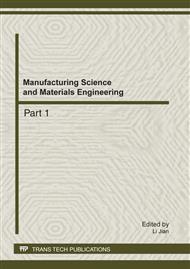[1]
Liu Jie, Sun Guangfu. Theory Of Anti-Resonant Vibrating Machine With Application[J]. Journal of Northeastern University (Natural Science). 1995, 16(1): 82-86.
Google Scholar
[2]
J Liu, G F Sun, B X Tang , B C Wen. Application Of Antiresonant Theory In Vibration Utilization Engineering[C], Proceeding Of Ninth World Congress On The Theory Of Machine And Mechanism, 1995. 8: 1093-1097.
Google Scholar
[3]
HUANG Zhichao. Theoretical Analysis on Fuzzy Reliability of Multi-degree-of-freedom Anti-resonant Machinery[J] . Journal of East China Jiaotong University, 2006, (01): 129-131.
Google Scholar
[4]
HUANG Zhichao. Theoretical Analysis on Fuzzy Reliability of Multi-degree-of-freedom Anti-resonant Machinery[J] . Journal of East China Jiaotong University, 2006, (01): 129-131.
Google Scholar
[5]
LIU Jie, LI Yungong, LIU Jintao, XU Huixi. Dynamical Analysis And Control Of Driving Point Anti-Resonant Vibrating Machine Based On Amplitude Stability[J]. Chinese Journal of Mechanical Engineering. 2006, 42(1): 145-148.
DOI: 10.3901/jme.2006.01.145
Google Scholar
[6]
Wen Bangchun, Liu Shuying, He Jing. Theory And Dynamic Design Of Vibration Machine[M]. Beijing. Mechanical Industry Press : (2001).
Google Scholar
[7]
Liu Jie, Liu Jintao, Zhang Jinping, Li Yungong. Dynamic Analysis Of Anti-Resonant Vibrating Machines With Random Oscillation Of Material Mass[J]. Journal of Vibration and Shock. Vol. 25. No. 6, 2006(6)76-78.
Google Scholar
[8]
Nayfeh, A. H., Introduction to Perturbation Techniques[M], John Wiley and Sons, New York. (1993).
Google Scholar
[9]
Delamotte, B., 1993, Non-perterbative Method for Solving Differential Equations and Finding Limit Cycles[J], Phys. Rev. Lett., 70 : 3361–3364.
DOI: 10.1103/physrevlett.70.3361
Google Scholar
[10]
Liao, S. J., and Chwang, A. T., 1998, Application of Homotopy Analysis Method in Nonlinear Oscillations[J], ASME J. Appl. Mech., 65: 914–922.
DOI: 10.1115/1.2791935
Google Scholar
[11]
J.H. He, Variational iteration method—a kind of non-linear analytical technique: some examples[J], Internat. J. Nonlinear Mech. 34 (4) 1999: 699–708.
DOI: 10.1016/s0020-7462(98)00048-1
Google Scholar
[12]
Dai. L, Han. Q, Xu. L. Semi-analytical and numerical solutions of multi-degree-of-freedom nonlinear oscillation systems with linear coupling [J]. Communications in Nonlinear Science and Numerical Simulation, 11, 7, 2006(10): 831-844.
DOI: 10.1016/j.cnsns.2004.12.009
Google Scholar
[13]
WANG Fujun1, LI Yaojun1, Han K. A general finite element model for numerical simulation of structure dynamics [J]. Science in China Series G: Physics, Mechanics&Astronomy, 49(4), 2006: 440-450.
DOI: 10.1007/s11433-006-2011-1
Google Scholar
[14]
B.G. Galerkin. Series solution of some problems of elastic equilibrium of rods and plates(Russian). Vest. Inzh. Tech, 1915(19): 897-908.
Google Scholar


